| dc.contributor.author | Luterbacher, Jürg | |
| dc.contributor.author | Werner, Johannes | |
| dc.contributor.author | Smerdon, Jason E. | |
| dc.contributor.author | Fernández-Donado, Laura | |
| dc.contributor.author | González-Rouco, Fidel J. | |
| dc.contributor.author | Barriopedro, David E. | |
| dc.contributor.author | Ljungqvist, Fredrik Carpentier | |
| dc.contributor.author | Büntgen, Ulf | |
| dc.contributor.author | Zorita, Eduardo Valera | |
| dc.contributor.author | Wagner, Sebastian | |
| dc.contributor.author | Esper, Jan | |
| dc.contributor.author | McCarroll, Danny | |
| dc.contributor.author | Toreti, Andrea | |
| dc.contributor.author | Frank, David C. | |
| dc.contributor.author | Jungclaus, Jojann H. | |
| dc.contributor.author | Barriendos, Mariano | |
| dc.contributor.author | Bertolin, Chiara | |
| dc.contributor.author | Bothe, Oliver | |
| dc.contributor.author | Brázdil, Rudolf | |
| dc.contributor.author | Camuffo, Dario | |
| dc.contributor.author | Dobrovolný, Petr | |
| dc.contributor.author | Gagen, Mary H. | |
| dc.contributor.author | Garcia-Bustamante, Elena | |
| dc.contributor.author | Ge, Q. | |
| dc.contributor.author | Guiot, Joël | |
| dc.contributor.author | Gómez-Navarro, Juan José | |
| dc.contributor.author | Hao, Z. | |
| dc.contributor.author | Hegerl, Gabi C. | |
| dc.contributor.author | Holmgren, Karin | |
| dc.contributor.author | Klimenko, Vladimir V. | |
| dc.contributor.author | Martin-Chivelet, Javier | |
| dc.contributor.author | Pfister, Christian | |
| dc.contributor.author | Roberts, Neil | |
| dc.contributor.author | Schindler, Anne | |
| dc.contributor.author | Schurer, Andrew P. | |
| dc.contributor.author | Solomina, Olga N. | |
| dc.contributor.author | Von Gunten, Lucien | |
| dc.contributor.author | Wahl, Eugene R. | |
| dc.contributor.author | Wanner, Heinz | |
| dc.contributor.author | Wetter, Oliver | |
| dc.contributor.author | Xoplaki, Elena | |
| dc.contributor.author | Yuan, Naiming | |
| dc.contributor.author | Zanchettin, Davide | |
| dc.contributor.author | Zhang, Huan | |
| dc.contributor.author | Zerefos, Christos S. | |
| dc.date.accessioned | 2021-04-15T07:42:28Z | |
| dc.date.available | 2021-04-15T07:42:28Z | |
| dc.date.created | 2016-07-31T17:08:47Z | |
| dc.date.issued | 2016 | |
| dc.identifier.issn | 1748-9326 | |
| dc.identifier.uri | https://hdl.handle.net/11250/2737850 | |
| dc.description.abstract | The spatial context is critical when assessing present-day climate anomalies, attributing them to potential forcings and making statements regarding their frequency and severity in a long-term perspective. Recent international initiatives have expanded the number of high-quality proxy-records and developed new statistical reconstruction methods. These advances allow more rigorous regional past temperature reconstructions and, in turn, the possibility of evaluating climate models on policy-relevant, spatio-temporal scales. Here we provide a new proxy-based, annually-resolved, spatial reconstruction of the European summer (June–August) temperature fields back to 755 CE based on Bayesian hierarchical modelling (BHM), together with estimates of the European mean temperature variation since 138 BCE based on BHM and composite-plus-scaling (CPS). Our reconstructions compare well with independent instrumental and proxy-based temperature estimates, but suggest a larger amplitude in summer temperature variability than previously reported. Both CPS and BHM reconstructions indicate that the mean 20th century European summer temperature was not significantly different from some earlier centuries, including the 1st, 2nd, 8th and 10th centuries CE. The 1st century (in BHM also the 10th century) may even have been slightly warmer than the 20th century, but the difference is not statistically significant. Comparing each 50 yr period with the 1951–2000 period reveals a similar pattern. Recent summers, however, have been unusually warm in the context of the last two millennia and there are no 30 yr periods in either reconstruction that exceed the mean average European summer temperature of the last 3 decades (1986–2015 CE). A comparison with an ensemble of climate model simulations suggests that the reconstructed European summer temperature variability over the period 850–2000 CE reflects changes in both internal variability and external forcing on multi-decadal time-scales. For pan-European temperatures we find slightly better agreement between the reconstruction and the model simulations with high-end estimates for total solar irradiance. Temperature differences between the medieval period, the recent period and the Little Ice Age are larger in the reconstructions than the simulations. This may indicate inflated variability of the reconstructions, a lack of sensitivity and processes to changes in external forcing on the simulated European climate and/or an underestimation of internal variability on centennial and longer time scales. | en_US |
| dc.language.iso | eng | en_US |
| dc.publisher | IOP Publishing | en_US |
| dc.rights | Navngivelse 4.0 Internasjonal | * |
| dc.rights.uri | http://creativecommons.org/licenses/by/4.0/deed.no | * |
| dc.title | European summer temperatures since Roman times | en_US |
| dc.type | Journal article | en_US |
| dc.type | Peer reviewed | en_US |
| dc.description.version | publishedVersion | en_US |
| dc.rights.holder | Copyright 2016 IOP Publishing Ltd | en_US |
| dc.source.articlenumber | 024001 | en_US |
| cristin.ispublished | true | |
| cristin.fulltext | original | |
| cristin.qualitycode | 1 | |
| dc.identifier.doi | 10.1088/1748-9326/11/2/024001 | |
| dc.identifier.cristin | 1369792 | |
| dc.source.journal | Environmental Research Letters | en_US |
| dc.source.40 | 11 | |
| dc.source.14 | 2 | |
| dc.identifier.citation | Environmental Research Letters. 2016, 11 (2), 024001. | en_US |
| dc.source.volume | 11 | en_US |
| dc.source.issue | 2 | en_US |

